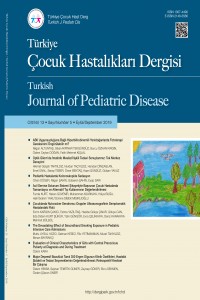Abstract
References
- 1. Yaseen H, Khalaf M, Rashid N, Darwich M. Does prophylactic phototherapy prevent hyperbilirubinemia in neonates with AB0 incompatibility and positive Coombs’ test? J Perinatol 2005;25:590-4.
- 2. Sarici SU, Yurdakök M, Serdar MA, Oran O, Erdem G, Tekinalp G, et al. An early (sixth-hour) serum bilirubin measurement is useful in predicting the development of significant hyperbilirubinemia and severe AB0 hemolytic disease in a selective high-risk population of newborns with AB0 incompatibility. Pediatrics 2002;109:e53.
- 3. Sgro M, Campbell D, Shah V. Incidence and causes of severe neonatal hyperbilirubinemia in Canada. CMAJ 2006;12:587-90.
- 4. American Academy of Pediatrics Subcommittee on Hyperbilirubinemia. Management of hyperbilirubinemia in the newborn infant 35 or more weeks of gestation. Pediatrics 2004;114:297-316.
- 5. Clifford JH, Mathews P, Reiquam CW, Palmer HD. Screening for hemolytic disease of the newborn by cord blood Coomb testing: Analysis of a five-year experience. Clin Pediatrics 1968;7:465-9.
- 6. Alter AA, Feldman F, Twersky J, De Vos E, Prutting DL, Miotti A, et al. Direct antiglobulin test in AB0 hemolytic disease of the newborn. Obstet Gynec 1969;33:846-51.
AB0 Uygunsuzluğuna Bağlı Hiperbilirubinemili Yenidoğanlarda Fototerapi Gereksinimi Öngörülebilir mi?
Abstract
Amaç: Çalışmada, AB0 uygunsuzluğuna bağlı indirekt hiperbilirubinemi (İHB) gelişen yenidoğanlarda, fototerapi gereksinimini ilk gün saptayabilecek belirteçler araştırıldı.
Gereç ve Yöntemler: Anne-bebek arasında AB0 uygunsuzluğu olan, zamanında doğmuş, ek hastalığı olmayan sağlıklı yenidoğanlar ileriye dönük izlem amacıyla çalışmaya alındı. Olguların ilk 6. ve 24. saatlerinde hemoglobin (Hgb), bilirubin ve laktat dehidrogenaz (LDH) düzeylerine bakıldı. Olguların ilk 15 gün Bhutani nomogramına uygun sıklıkta serum bilirubin düzeyleri takip edildi ve fototerapi gereksinimi Amerikan Pediatri Akademisi’nin önerdiği sınırlar kullanılarak belirlendi. Fototerapi sınırını geçerek fototerapi uygulanan bebeklerle, fototerapi sınırının altında kalanların sonuçları karşılaştırıldı.
Bulgular: AB0 uygunsuzluğu nedeniyle çalışmaya alınan 83 bebekten 18’inde B0 (%21.7), 65’inde (%78.3) A0 uygunsuzluğu saptandı. Bebeklerin 44’ünde (%53) direkt antiglobulin testi (DAT) pozitifti. DAT pozitif olan yenidoğanların 13’ü (%33.3), DAT negatif olanların ise 12’si (%27.3) izlemde İHB nedeniyle fototerapi aldı. İki grup arasında yatış sıklığı açısından anlamlı fark yoktu (p=0.58).
İndirekt hiperbilirubinemi nedeniyle fototerapi uygulanan ve uygulanmayan gruplar arasında 6. ve 24. saat Hgb ile LDH düzeyleri arasında anlamlı fark saptanmadı (p>0.05). Ancak, fototerapi gereksinimi olan hiperbilirubinemili bebeklerde 24. saat bilirubin düzeyleri, fototerapi ihtiyacı olmayanlara göre daha yüksek bulundu (p=0.03).
Sonuç: Yenidoğanlarda AB0 uygunsuzluğuna bağlı İHB nedeniyle fototerapi gereksiniminin belirlenmesinde, 24. saat Hgb, DAT ve LDH düzeylerinin prediktif değeri yoktur, ancak 24. saat bilirubin düzeyi prediktif olabilir. AB0 uygunsuzluğuna bağlı hemolitik hastalık spektrumunun geniş olması nedeniyle, AB0 uygunsuzluğu olan yenidoğanların yakın izlenmeleri gerektiği düşünülmüştür.
References
- 1. Yaseen H, Khalaf M, Rashid N, Darwich M. Does prophylactic phototherapy prevent hyperbilirubinemia in neonates with AB0 incompatibility and positive Coombs’ test? J Perinatol 2005;25:590-4.
- 2. Sarici SU, Yurdakök M, Serdar MA, Oran O, Erdem G, Tekinalp G, et al. An early (sixth-hour) serum bilirubin measurement is useful in predicting the development of significant hyperbilirubinemia and severe AB0 hemolytic disease in a selective high-risk population of newborns with AB0 incompatibility. Pediatrics 2002;109:e53.
- 3. Sgro M, Campbell D, Shah V. Incidence and causes of severe neonatal hyperbilirubinemia in Canada. CMAJ 2006;12:587-90.
- 4. American Academy of Pediatrics Subcommittee on Hyperbilirubinemia. Management of hyperbilirubinemia in the newborn infant 35 or more weeks of gestation. Pediatrics 2004;114:297-316.
- 5. Clifford JH, Mathews P, Reiquam CW, Palmer HD. Screening for hemolytic disease of the newborn by cord blood Coomb testing: Analysis of a five-year experience. Clin Pediatrics 1968;7:465-9.
- 6. Alter AA, Feldman F, Twersky J, De Vos E, Prutting DL, Miotti A, et al. Direct antiglobulin test in AB0 hemolytic disease of the newborn. Obstet Gynec 1969;33:846-51.
Details
| Primary Language | Turkish |
|---|---|
| Subjects | Internal Diseases |
| Journal Section | ORIGINAL ARTICLES |
| Authors | |
| Publication Date | September 23, 2019 |
| Submission Date | June 13, 2018 |
| Published in Issue | Year 2019 Volume: 13 Issue: 5 |
Cite
Cited By
Prognostic evaluation of newborns with neonatal hyperbilirubinemia
Journal of Medicine and Palliative Care
https://doi.org/10.47582/jompac.1398442
The publication language of Turkish Journal of Pediatric Disease is English.
Manuscripts submitted to the Turkish Journal of Pediatric Disease will go through a double-blind peer-review process. Each submission will be reviewed by at least two external, independent peer reviewers who are experts in the field, in order to ensure an unbiased evaluation process. The editorial board will invite an external and independent editor to manage the evaluation processes of manuscripts submitted by editors or by the editorial board members of the journal. The Editor in Chief is the final authority in the decision-making process for all submissions. Articles accepted for publication in the Turkish Journal of Pediatrics are put in the order of publication taking into account the acceptance dates. If the articles sent to the reviewers for evaluation are assessed as a senior for publication by the reviewers, the section editor and the editor considering all aspects (originality, high scientific quality and citation potential), it receives publication priority in addition to the articles assigned for the next issue.
The aim of the Turkish Journal of Pediatrics is to publish high-quality original research articles that will contribute to the international literature in the field of general pediatric health and diseases and its sub-branches. It also publishes editorial opinions, letters to the editor, reviews, case reports, book reviews, comments on previously published articles, meeting and conference proceedings, announcements, and biography. In addition to the field of child health and diseases, the journal also includes articles prepared in fields such as surgery, dentistry, public health, nutrition and dietetics, social services, human genetics, basic sciences, psychology, psychiatry, educational sciences, sociology and nursing, provided that they are related to this field. can be published.


